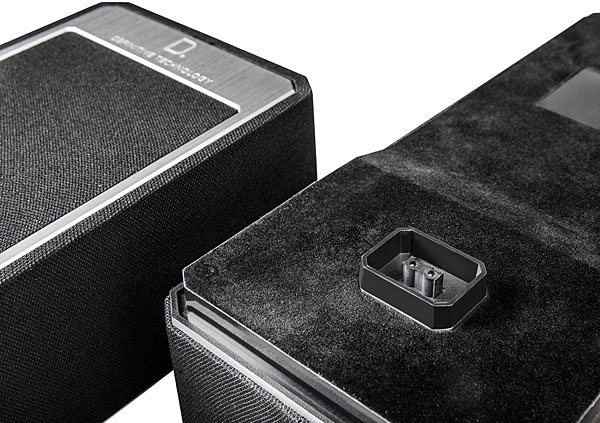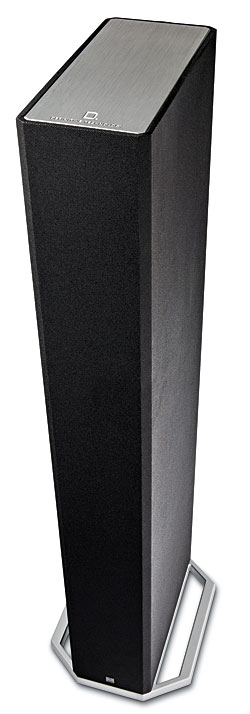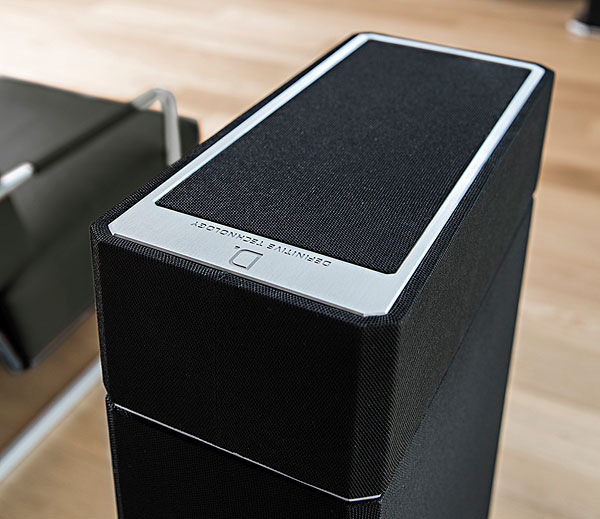Definitive Technology BP9080x Speaker System Review Page 2
The Sound
The BP9080x towers are big speakers, and they sound like it. In fact, they sound huge: way huge. On top-shelf stereo music recordings, the soundstage is crazily deep but still impressively focused. For example, I have a live semi-pro performance of the music from Milhaud’s ballet La création du monde, captured eons ago on two-channel 15-inch-per-second tape with an X-Y/MS microphone setup (a trifle noisy by today’s standards but still goosebump-raising) and ripped to 96/24 FLAC. This sounded on-stage real, with the French composer’s unique small ensemble widely and deeply arrayed; the snare-drum rolls came from the back of the stage, while piano accents came from hardfront-and-center. Even something as quotidian as a baseball game in 2.0 sounded beguilingly full. Crowd noise arced back and around, well out beyond the speakers, carrying a three-dimensionality that you simply don’t get from direct radiators.

The usual drawback is, as already mentioned, a sacrifice in tightly imaged front stage, particularly on centered soloists—but the BP9080x towers didn’t display this to nearly the degree I’ve heard from most other bipoles. A track like Suzanne Vega’s classic “Tom’s Diner,” vocally recorded utterly dry and hard-center, sounded, well, almost utterly dry and hard-center. The BP9080x pair produced an audibly bigger bubble of voice than do my everyday (direct-radiating) speakers, which focus the voice into a tight, dense ball of sound. On the bipole towers, that bubble of voice, though bigger in all three dimensions, was still dramatically tight and timbrally parched, thus doing no real disservice to the artist’s “interior-voice” intent.
The BP9080x’s tonal balance was in line with that of previous Definitive BP towers—which is to say, neutral indeed through the vocal range, for a scrupulous presentation of both male and female voices; the Vega track had already suggested so. But direct comparisons with my long-term Energy Veritas speakers weren’t as oranges-to-oranges as usual, because the towers’ bipole soundfield changes one’s perception of tone color. Mine, anyway: Everything sounds slightly warmer, not in the usual sense of more lower-mids but in some other, almost ineffable way. It’s a euphonic, beguiling, big, inviting sound, one that is at its very best on fine stereo full-orchestra material like Rachmaninoff’s Symphonic Dances (from a Reference Recordings CD), which presented a gorgeously deep and wide soundstage with clear and abundantly airy treble. Again, the sense of instrumental location and focus was less tight and precise than that from my everyday speakers (or most other excellent directradiators), but this was actually more faithful to what you hear in a concert hall. The highlighted localization that highend systems deliver from many recordings isn’t what we get in the ambient, highly reflective environment of a hall. There, the feeling is of organic envelopment, which almost makes you un-yearn for music in surround sound.
 The BP9080x is as full range a loudspeaker as you’ll find anywhere. Deep-bass chestnuts like the SaintSaëns Organ Symphony were child’s play, and when I streamed my handful of dubstep tracks (kept on hand strictly for scientific purposes, of course), I was rewarded with a sub-30-hertz bottom that held firm up to insane overall levels, which threatened to loosen floor joists and induce a vague sense of impending nausea. Raising the BP9080x’s Intelligent Bass Control can handily deliver the bass-heavy slammin’ that some owners will inevitably choose. And for the record, the BP9080x will play ridiculously loud, without outstripping its bass section; the 120-ish-watt-per-channel AVR I was using (for its Atmos surround processing) had no difficulty exceeding my preferred levels by a comfortable margin.
The BP9080x is as full range a loudspeaker as you’ll find anywhere. Deep-bass chestnuts like the SaintSaëns Organ Symphony were child’s play, and when I streamed my handful of dubstep tracks (kept on hand strictly for scientific purposes, of course), I was rewarded with a sub-30-hertz bottom that held firm up to insane overall levels, which threatened to loosen floor joists and induce a vague sense of impending nausea. Raising the BP9080x’s Intelligent Bass Control can handily deliver the bass-heavy slammin’ that some owners will inevitably choose. And for the record, the BP9080x will play ridiculously loud, without outstripping its bass section; the 120-ish-watt-per-channel AVR I was using (for its Atmos surround processing) had no difficulty exceeding my preferred levels by a comfortable margin.
The CS9080 center is a direct-radiator design, complemented by a powered upfiring woofer/passive-radiator duo that extends its own response unusually low for a center speaker—though, to be sure, it’s no bantam. (I found virtually no penalty in running it full range but left it crossed over at 60 Hz most of the time.) The CS9080’s tonal match to the front tower pair was actually quite close—a touch brighter, perhaps—but nonetheless, it sounded quite different in direct dual-mono/one-speaker-mono comparisons. Here, the effects of both twospeaker versus one and bipole versus monopole were dramatically audible: The CS9080 sounded much closer, sharper, and more focused. However you want to characterize it, the difference was obvious. Yet back in stereo or surround modes, the center never stuck out or seemed to jump on panning sounds.
If all of that seems like a perfect prescription for hugely ambient, dynamic, extended, and wow-inducing surround theater: yes. Eager to feed the suite a Dolby Atmos gala, I cued up the deeply dopey but sonically satisfying Pixels and began thumbing my way through. A scene like the pixelization of the teenage boy at the Taj Mahal did the trick nicely: The pixel blocks flew up, over, and around with amazing cohesion, never sucking into one speaker or another. The “Centipede” scene in the next chapter was an even clearer demo of Atmos dimensionality. While the worms never seemed to be coming from overhead per se, the sense of height and upward-extending space was strong. (Interestingly, the movie’s sound designers didn’t opt to put ambience in the height channels, at least not for the most obvious scenes—such as the warehouse government-skunkworks speech, where Josh Gad’s richly echoed voice lacked any overhead reflections at all. Opportunity missed, in my opinion.)

The BP9080x towers managed the exaggerated, movie-magic bass levels of Pixels without succumbing to boom or bloat, but they still delivered the rolling, floor-bending bottom that the biggest cues demanded. Equally impressive, the system would produce much the same balance at any level I asked, even many decibels beyond comfortable listening levels, for nearly frightening impact on stuff like the U-571 depth-charge sequences. Despite the center speaker’s distinct design and modestly different tonality, dialogue was reliably clear and intelligible, and I didn’t note any obvious tone- or space-shifting as effects panned across the front stage. Full-system music cues like the credits chapter of Master and Commander: The Far Side of the World were gorgeously clear yet full, for a net effect as close to the best breed of commercial cinema as you’re likely to encounter.
Aural memory is notorious, but I’m confident that Definitive Technology’s new generation of BP tower is a notable refinement of a proven and popular concept. It’s big, brawny, and powerful, but not at any expense of delicacy or spatial ability. The bigness, of course, extends to the price tag: $7,200, the cost for this top-of-the-line system, will buy a wide variety of very serious, “value/high-end” surround systems of more conventional design and same-but-different range and finesse. As with any loudspeaker choice, it’s a matter of taste—but more so given what remains the BP9000 series’ uncommon bipolar approach. Either way, any dedicated HT-head will want an audition to hear what bipoles have to offer and how Definitive Technology’s latest does it.
























































